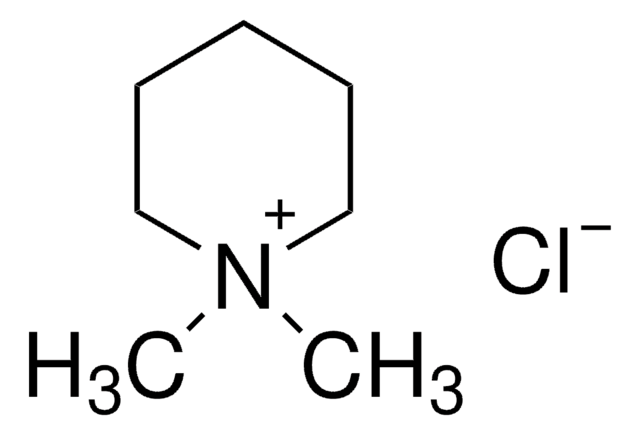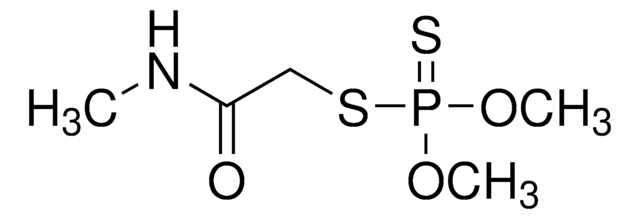38117
Mepiquat chloride
certified reference material, TraceCERT®, Manufactured by: Sigma-Aldrich Production GmbH, Switzerland
동의어(들):
1,1-Dimethylpiperidinium chloride
로그인조직 및 계약 가격 보기
모든 사진(1)
About This Item
실험식(Hill 표기법):
C7H16ClN
CAS Number:
Molecular Weight:
149.66
Beilstein:
3914089
MDL number:
UNSPSC 코드:
41116107
NACRES:
NA.24
추천 제품
Grade
certified reference material
Quality Level
제품 라인
TraceCERT®
grade
TraceCERT®
유통기한
limited shelf life, expiry date on the label
제조업체/상표
Manufactured by: Sigma-Aldrich Production GmbH, Switzerland
저장 온도
2-8°C
SMILES string
[Cl-].C[N+]1(C)CCCCC1
InChI
1S/C7H16N.ClH/c1-8(2)6-4-3-5-7-8;/h3-7H2,1-2H3;1H/q+1;/p-1
InChI key
VHOVSQVSAAQANU-UHFFFAOYSA-M
유사한 제품을 찾으십니까? 방문 제품 비교 안내
관련 카테고리
일반 설명
This certified reference material (CRM) is produced and certified in accordance with ISO/IEC 17025 and ISO 17034. This CRM is traceable to primary material from an NMI, e.g. NIST or NMIJ. Certified content by quantitative NMR incl. uncertainty and expiry date are given on the certificate. Download your certificate at: http://www.sigma-aldrich.com
Mepiquat chloride is a synthetic plant growth regulator that is absorbed by the foliage and translocated throughout the plant. It is widely used to manipulate plant structure and helps to combat excessive vegetative growth, which if left uncontrolled can lead to undesirable fruit shed, boll rot, and yield reductions. Mepiquat chloride inhibits gibberellic acid synthesis, thus reducing cell enlargement and cell division rate. Application of mepiquat chloride in cotton results in a more compact plant caused by shortened internode elongation, reduced main stem nodes and decreased leaf expansion and leaf area.
Mepiquat chloride is approved for use in European Union (EU) following Regulation (EC) No 1107/2009 (repealing Directive 91/414/EEC). The maximum residue level (MRL) for Mepiquat (sum of mepiquat and its salts, expressed as mepiquat chloride) is established from 0.02 mg/kg to 4 mg/kg for many plant-based products and 40 mg/kg for linseed, mustard, sunflower, and poppy seeds. For products of animal origin, the MRL is set from 0.05 mg/kg to 0.8 mg/kg as per Reg. (EU) 2021/976.
Mepiquat has to be monitored in the Multiannual Control Programme for Pesticides Residues (MACP), run within the EU and EFTA in/on products of plant origin.
Mepiquat chloride is a synthetic plant growth regulator that is absorbed by the foliage and translocated throughout the plant. It is widely used to manipulate plant structure and helps to combat excessive vegetative growth, which if left uncontrolled can lead to undesirable fruit shed, boll rot, and yield reductions. Mepiquat chloride inhibits gibberellic acid synthesis, thus reducing cell enlargement and cell division rate. Application of mepiquat chloride in cotton results in a more compact plant caused by shortened internode elongation, reduced main stem nodes and decreased leaf expansion and leaf area.
Mepiquat chloride is approved for use in European Union (EU) following Regulation (EC) No 1107/2009 (repealing Directive 91/414/EEC). The maximum residue level (MRL) for Mepiquat (sum of mepiquat and its salts, expressed as mepiquat chloride) is established from 0.02 mg/kg to 4 mg/kg for many plant-based products and 40 mg/kg for linseed, mustard, sunflower, and poppy seeds. For products of animal origin, the MRL is set from 0.05 mg/kg to 0.8 mg/kg as per Reg. (EU) 2021/976.
Mepiquat has to be monitored in the Multiannual Control Programme for Pesticides Residues (MACP), run within the EU and EFTA in/on products of plant origin.
애플리케이션
The certified reference material (CRM) is intended to be used as a calibrant for chromatography and other analytical techniques. Mepiquat chloride CRM can also be used to:
- Evaluate the influence of plant density on cotton response to mepiquat chloride application in order to isolate a specific combination for optimizing plant stature and yield
- Quantify the growth and physiological responses of cotton plants to temperature regimes and mepiquat chloride rates
- Quantify the efficacy of mepiquat chloride on plant height, culm morphological characteristics, lignin accumulation, related enzyme activities, and its relationship with lodging resistance in maize
- Evaluate the roles of gibberellic acid metabolism and signaling in mepiquat chloride-induced inhibition of internode elongation in cotton seedlings
- Evaluate the effects of different mepiquat chloride concentrations on morphological and physiological changes in Eucalyptus clones
추천 제품
Find a digital Reference Material for this product available on our online platform ChemisTwin® for NMR. You can use this digital equivalent on ChemisTwin® for your sample identity confirmation and compound quantification (with digital external standard). An NMR spectrum of this substance can be viewed and an online comparison against your sample can be performed with a few mouseclicks. Learn more here and start your free trial.
법적 정보
TraceCERT is a registered trademark of Merck KGaA, Darmstadt, Germany
신호어
Warning
유해 및 위험 성명서
Hazard Classifications
Acute Tox. 4 Oral - Aquatic Chronic 3
Storage Class Code
11 - Combustible Solids
WGK
WGK 2
Flash Point (°F)
Not applicable
Flash Point (°C)
Not applicable
가장 최신 버전 중 하나를 선택하세요:
자사의 과학자팀은 생명 과학, 재료 과학, 화학 합성, 크로마토그래피, 분석 및 기타 많은 영역을 포함한 모든 과학 분야에 경험이 있습니다..
고객지원팀으로 연락바랍니다.







